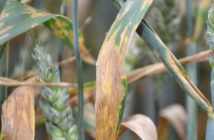“We believe that the 2014 growing season highlighted the unique benefits of Belepi wheat for growers – and proved its performance at a farm scale,” says Tom Nickerson of breeders agents Ebbage Seeds. “As we look towards spring sowing plans for 2015, Belepi scores four pluses for wheat growers.”
First, with CAP reform and introduction of the three crop ruling under crop diversification measures, Belepi is in a unique position that is to the grower’s advantage, as it is considered a winter wheat so far as agrochemical programmes are concerned, and as a spring wheat for crop diversification purposes.
Second, Belepi has a wide sowing window, through to the end of March, allowing time to achieve a good seedbed – for example, when following root crops where soil structure has been compromised.
Third, BELEPI provides the opportunity to employ practical blackgrass control methods prior to drilling. BELEPI has a prostrate winter growth habit but is relatively dormant until the start of stem extension in late March. At this time it produces wide, lax leaves and develops much faster than long season winter wheat. The leafiness and speed of development out-competes weeds including blackgrass. Note that being winter dormant, increased seed rates will not aid blackgrass suppression. It is BELEPI’s competitiveness in April – growing faster and leafier – that gives the variety its excellent weed covering capability.
Fourth, Belepi is yield competitive. Comprehensive field-scale yield results from 2014 harvest based on both seed and commercial growers of BELEPI show that,in a range of growing conditions, yields have been competitive with other wheats on the farms. Yields ranged from well over 11 t/ha for the best crops, to an average of over 9 t/ ha for all the tracked crops, with drilling dates ranging from mid-October to mid-March.



